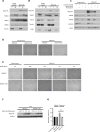MIA40 suppresses cell death induced by apoptosis-inducing factor 1
- PMID: 40055465
- PMCID: PMC11976965
- DOI: 10.1038/s44319-025-00406-8
MIA40 suppresses cell death induced by apoptosis-inducing factor 1
Abstract
Mitochondria harbor respiratory complexes that perform oxidative phosphorylation. Complex I is the first enzyme of the respiratory chain that oxidizes NADH. A dysfunction in complex I can result in higher cellular levels of NADH, which in turn strengthens the interaction between apoptosis-inducing factor 1 (AIFM1) and Mitochondrial intermembrane space import and assembly protein 40 (MIA40) in the mitochondrial intermembrane space. We investigated whether MIA40 modulates the activity of AIFM1 upon increased NADH/NAD+ balance. We found that in model cells characterized by an increase in NADH the AIFM1-MIA40 interaction is strengthened and these cells demonstrate resistance to AIFM1-induced cell death. Either silencing of MIA40, rescue of complex I, or depletion of NADH through the expression of yeast NADH-ubiquinone oxidoreductase-2 sensitized NDUFA13-KO cells to AIFM1-induced cell death. These findings indicate that the complex of MIA40 and AIFM1 suppresses AIFM1-induced cell death in a NADH-dependent manner. This study identifies an effector complex involved in regulating the programmed cell death that accommodates the metabolic changes in the cell and provides a molecular explanation for AIFM1-mediated chemoresistance of cancer cells.
Keywords: Cancer; Metabolism; Mitochondria; Programmed Cell Death; Protein Import.
© 2025. The Author(s).
Conflict of interest statement
Disclosure and competing interests statement. The authors declare no competing interests.
Figures












References
-
- Angerer H, Zwicker K, Wumaier Z, Sokolova L, Heide H, Steger M, Kaiser S, Nübel E, Brutschy B, Radermacher M et al (2011) A scaffold of accessory subunits links the peripheral arm and the distal proton-pumping module of mitochondrial complex I. Biochem J 437:279–288. 10.1042/bj20110359 - PMC - PubMed
-
- Banci L, Bertini I, Cefaro C, Ciofi-Baffoni S, Gallo A, Martinelli M, Sideris DP, Katrakili N, Tokatlidis K (2009) MIA40 is an oxidoreductase that catalyzes oxidative protein folding in mitochondria. Nat Struct Mol Bio 16:198–206. 10.1038/nsmb.1553 - PubMed
-
- Bartha Á, Győrffy B (2021) TNMplot.com: a web tool for the comparison of gene expression in normal, tumor and metastatic tissues. Int J Mol Sci 22:2622. 10.3390/ijms22052622 - PMC - PubMed
MeSH terms
Substances
Grants and funding
LinkOut - more resources
Full Text Sources
Research Materials

